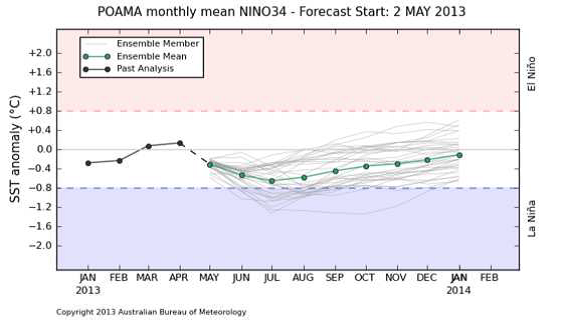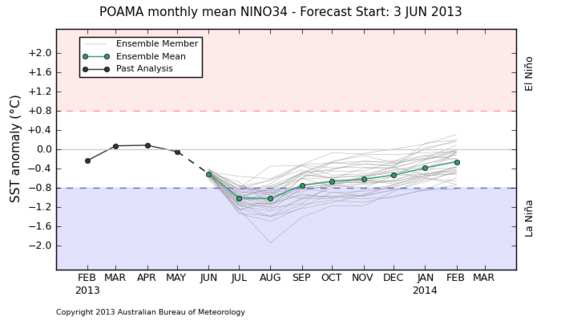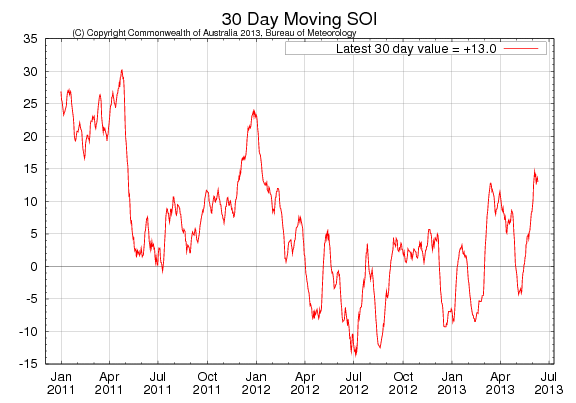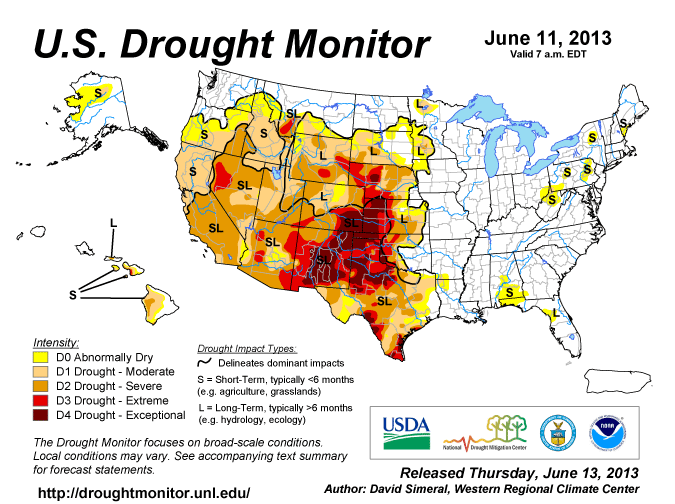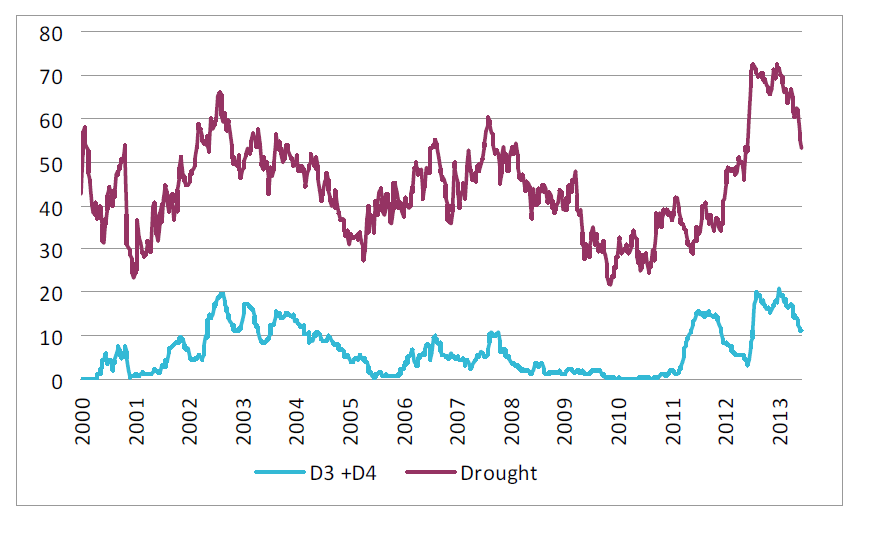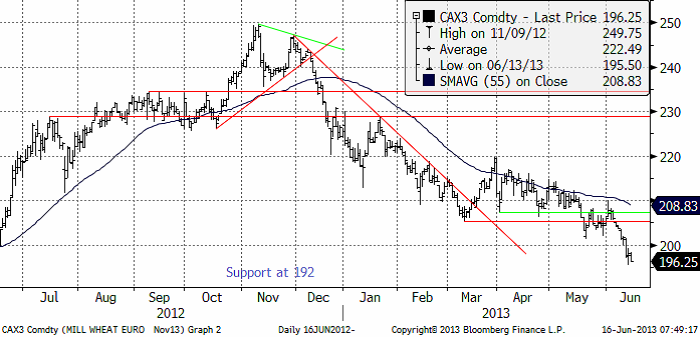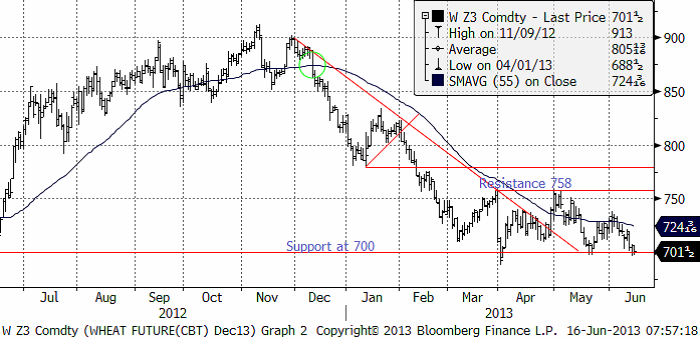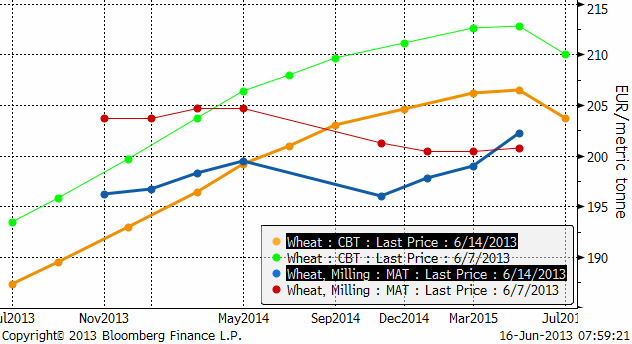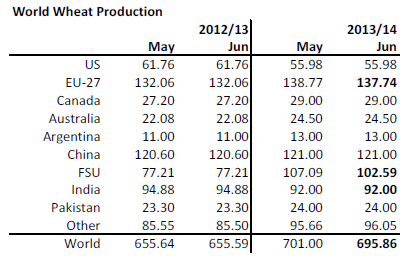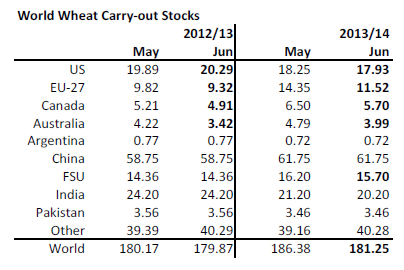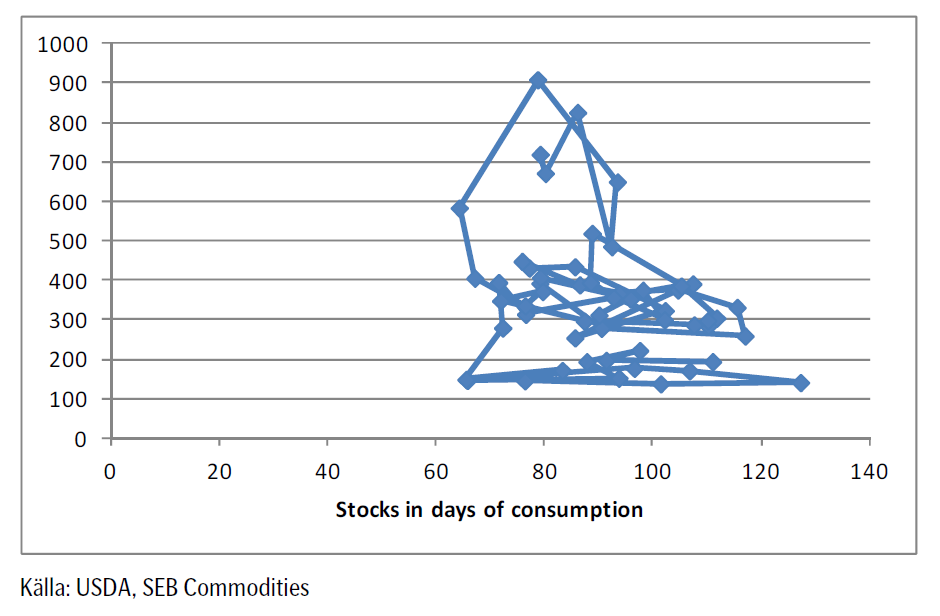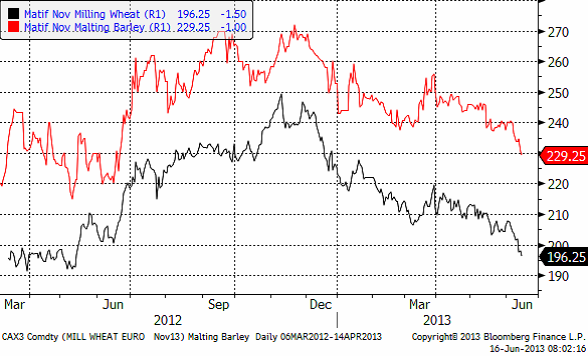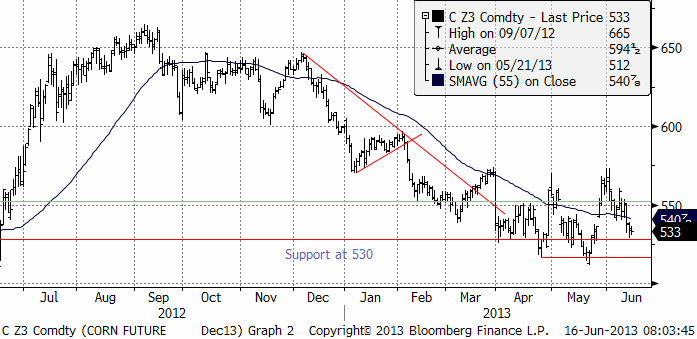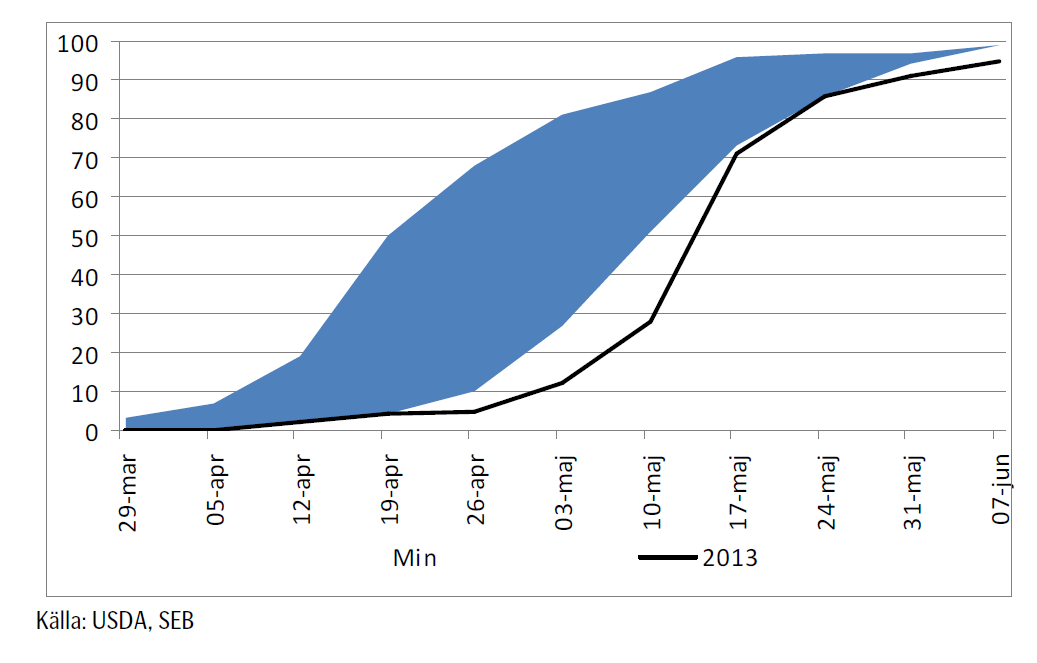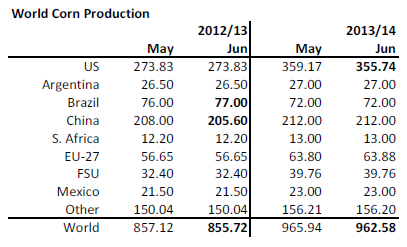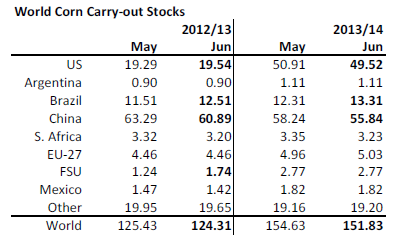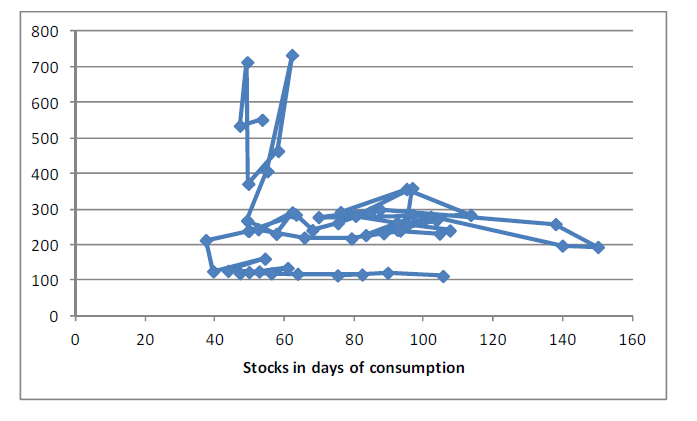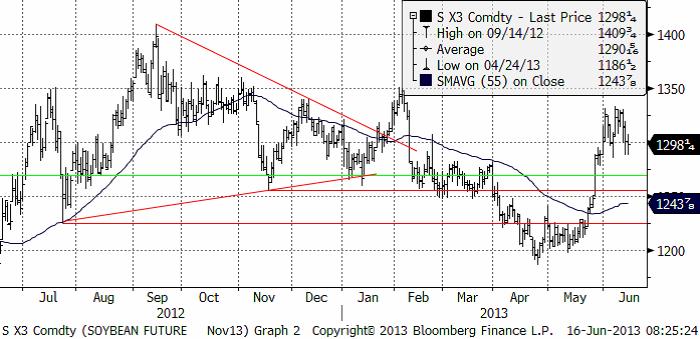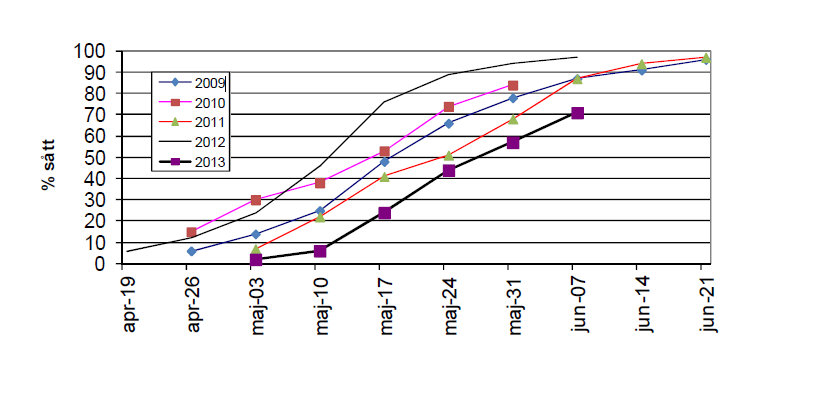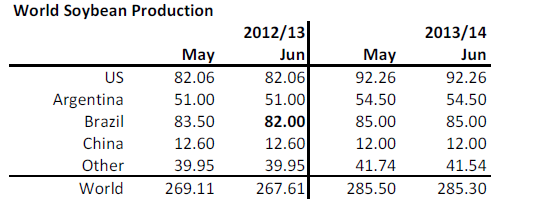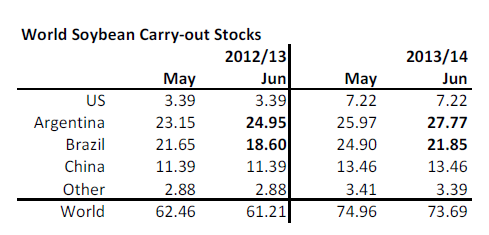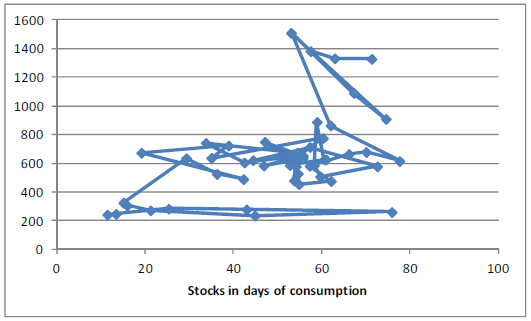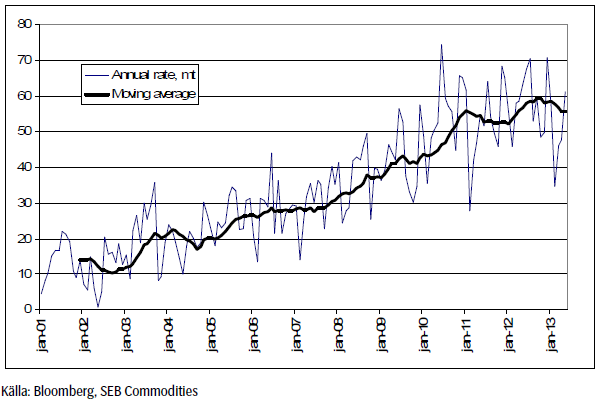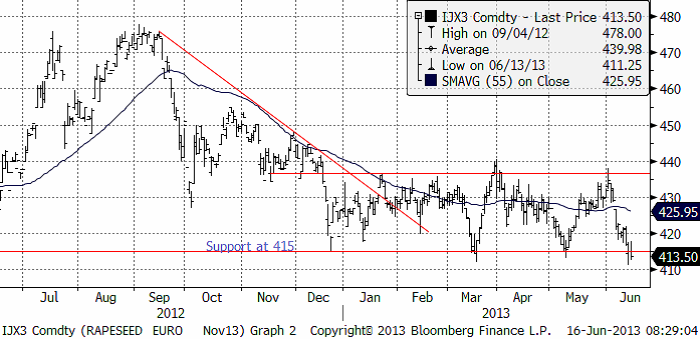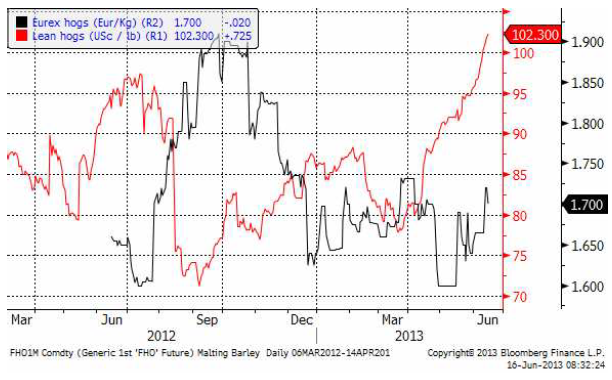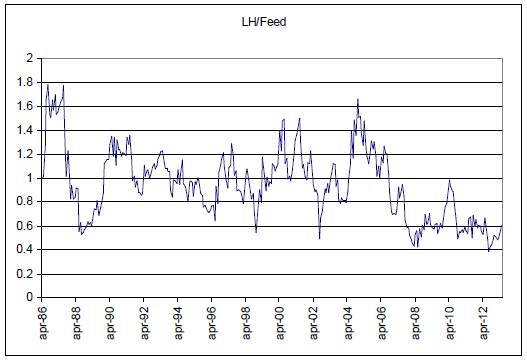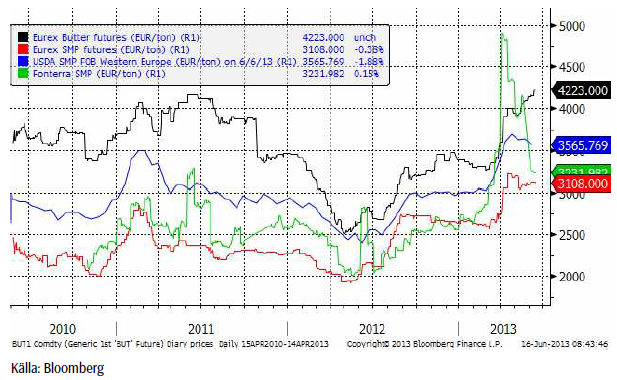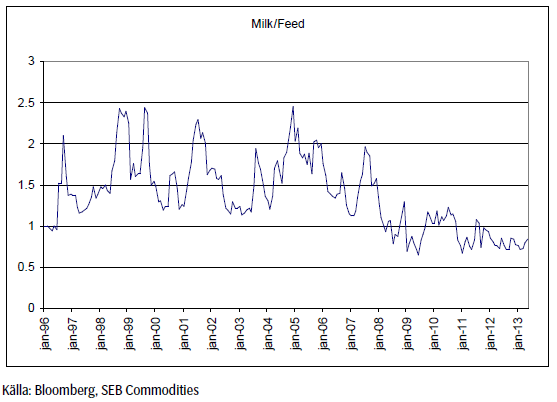Analys
SEB Jordbruksprodukter, 17 juni 2013
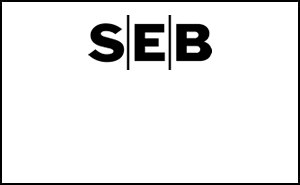

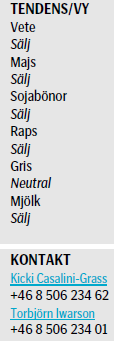 Det amerikanska jordbruksdepartementet publicerade juni månads WASDE-rapport i onsdags och den tolkades som negativ för vete, majs och sojabönor av marknaden. För vete var den inte nödvändigtvis negativ, men med enorm ny skörd av majs är det svårt att se att terminerna på vete skulle stiga.
Det amerikanska jordbruksdepartementet publicerade juni månads WASDE-rapport i onsdags och den tolkades som negativ för vete, majs och sojabönor av marknaden. För vete var den inte nödvändigtvis negativ, men med enorm ny skörd av majs är det svårt att se att terminerna på vete skulle stiga.
Regnen i Europa ökar utbudet av vete av sämre kvalitet, dvs av Matif-kvalitet. Detta kan förklara att Matif har fallit mer än priset på vete i Chicago.
Ett nytt La Niña har kommit upp på prognoskartan. Hur detta utvecklar sig återstår att ha koll på. Den har potential att ställa till med en del skada, framförallt för norra halvklotets skörd av majs och sojabönor. Den kommer lite för sent för att skada höstvetet.
Den 28 juni är det dags för plantings-rapport från USDA.
Nästa vecka kommer veckobrevet inte ut på måndag som vanligt, utan förmodligen på tisdag.
Odlingsväder
Vi tycker det är viktigast att upplysa om att ett La Niña helt oväntat kommit in i ensemble-prognosen från Australiens meteorologiska byrå. Detta har potential att ställa till med torka igen i USA och Ryssland senare i år.
Som vi ser höll sig prognosen säkert över La Niña-gränsen för en månad sedan. I den senaste prognosen, som vi ser nedan, prognosticeras nu La Niña-förhållanden under juli och augusti.
Faktum är att Southern Oscillation Index, har stigit väldigt raskt de senaste tio dagarna. SOI ligger nu på +13. Ett index över 8 indikerar La Niña-förhållanden och brukar hänga ihop med väder som är typiskt för La Niña.
I US Drought Monitor har torkan avtagit ytterligare, som vi ser i kartbilden nedan.
Andelen av USA:s yta som är påverkad av torka och de två mest extrema kategorierna av torka har minskat dramatiskt, som vi ser i nedanstående diagram.
Odlingsvädret i USA är alltså på väg att bli mycket bättre, men den gryende La Niña:n bör man hålla koll på för det framtida vädret.
Vete
Priset på novemberterminen på Matif föll i veckan som gick till 196.25 euro per ton. Tekniskt stöd finns på 192, men det är ett gammalt stöd och de jämna siffrorna 195 och 190 kanske attraherar fler limiterade köpordrar, som kan få prisfallet att stanna till där och kanske rekylera. WASDE-rapporten tolkades som negativ, men det är bara på håret att det blir en lagerökning i världen, när det gäller vete. För majs är det en annan femma, men för vete är det inte fullt så negativt. Dessutom, som vi såg ovan, håller det på att utveckla sig till ett La Niña igen, vilket skulle kunna skada majs- och sojaskörden på norra halvklotet. Australien gynnas dock av mer nederbörd, som brukar hänga ihop med La Niña där.
Decemberkontraktet på CBOT stängde i fredags på 701.50 cent per bushel. Det är precis ovanför det starka stödet på 700 cent. Skulle det brytas, t ex i veckan som kommer, signaleras ytterligare nedgång i terminspriset.
Nedan ser vi förändringen i terminskurvorna fredag till fredag. Chicago har sjunkit lika mycket för alla terminslöptider. Matif däremot noterar en uppgång i priset på terminer med löptid efter november 2014. Det innebär att Matif-kurvan nu uppvisar contango, vilket är ovanligt för den europeiska marknaden.
I onsdags presenterade det amerikanska jordbruksdepartementet World Agricultural Supply and Demand Estimates för juni. De sänkte produktionsestimatet i Europa och i före detta Sovjetunionen. Dessa sänkningar var väntade. Den ryska skörden sänktes med 2 mt, eller 3.6% sedan förra månaden. Detta är ändå 16.3 mt mer än förra året. USDA räknar med att ryssarna skördar 24.7 mha jämfört med 21.3 mha förra året. Förra året drabbades Ryssland av svår torka. USDA räknar med att hektarskörden för vete totalt blir 2.19 ton per hektar. Ungefär hälften av Rysslands vete är höstsått och den ger en skörd över genomsnittet. Vårsått vete ger lägre. 2.19 ton per hektar är 21% högre än förra året och 2% högre än genomsnittet de senaste fem åren. Vårsådden är klar nu eller är nästan klar.
Södra och norra Kaukasus har varit och är fortfarande mycket varmare än normalt med sämre skörd än normalt. Å andra sidan skriver USDA att förhållandena i Volga-regionen är utmärkta.
USDA sänkte också EU:s veteskörd till 137.74 beroende på nederbörden i östra Europa och i Italien. Översvämningarna av floderna räknar man med inte ha påverkat jordbruksmark, utan mer stadsbebyggelse längs floderna. Sedan rapporten har läget dock förvärrats på Balkan. Mer regn betyder mindre av bra brödkvalitet och mer av sämre kvalitet. En av anledningarna till prisfallet på Matif, är att leveransbar kvalitet är på gränsen till fodervete och att utbudet av detta alltså väntas öka på grund av vädret.
Den lägre produktionen återspeglar sig direkt i lägre estimerade utgående lager.
Det är nu i princip samma utgående lager estimerat som förra året – alltså ingen lagerökning. Som vi ser av diagrammet nedan, med utgående lager varje juni månad sedan 1960 och priset per cent per bushel på yaxeln, är vi nästan på samma ställe i diagrammet som för ett år sedan. Priset är lite högre och lagren är något lite lägre än de estimerades till för ett år sedan. Av relationen kan man dock se, att priset skulle kunna vara något lite lägre, för den här lagernivån. Därav prisfallet som följde på rapporten i onsdags.
Måndagens Crop Ratings hade minskat till 1% till 31% good / excellent. 5% var skördat i måndags för en vecka sedan. De första resultaten var inget vidare, men det var inte heller väntat. Normalt skulle skörden av höstvete ha nått till 16% klart.
ABARE (Australien) rapporterade ett skördeestimat som var högre än tidigare, på 25.4 mt. USDA ligger som vi såg ovan på 24.5 mt.
Den stora skörden i Ryssland är glädjande, men ryska statliga lager kommer att fyllas på först av allt.
Utbudet av spannmål, framförallt då majs, kommer att öka stort. Regnen i Europa ökar utbudet av den dåliga Matif-kvaliteten och det gör att vi ligger kvar med säljrekommendation på detta, trots att priset kommit ner så pass att det går att motivera ”neutral” rekommendation på dessa priser också.
Maltkorn
Maltkornet föll i veckan som gick i samklang med vetet på Matif och noterade en nedgång med lite drygt 10 euro per ton till 229.25 euro per ton.
Majs
Majspriset (december 2013) föll i veckan som gick och stängde på 533 cent per bushel (56 pund). Det är precis ovanför det tekniska stödet på 530 cent. Tekniskt ser bilden ut som mer ”sidledes” rörelse är att vänta, men prisfallet kan också få en fortsättning, beroende på hur veckans nyhetsflöde utvecklar sig.
Till förra helgen hade amerikanska lantbrukare lyckats ta sig till 95% sått. Crop condition är 63% i good eller excellent-kategori. Nedan ser vi årets sista diagram på såddens fortskridande i USA.
USDA höjer skörden 2012/13 (i år) i Brasilien till 77 mt. Det har kommit gynnsam nederbörd för den viktigare andra skörden, safrinha, som odlas efter sojabönor, men USDA skriver att man har samma hektarskördeestimat som i maj. Däremot har man höjt arealen med 200,000 hektar till 15.8 mha.
På grund av den sena sådden i USA sänker man skördeestimatet för 2013/14 till 355.74 mt.
På global basis väntas skörden öka med 107 mt från förra året, trots en sänkning av estimatet från förra månaden på totalt 3.4 mt.
Utgående lager 2012/13 sänktes 1 mt på global basis, beroende på den lägre skörden.
Nedan ser vi relationen mellan lager (på x-axeln) och pris. Varje punkt är läget i juni varje år sedan år 1960. Läget just nu ligger precis mitt emellan 700 cent och 400 cent. Man kan alltså motivera både ett mycket högre pris och ett mycket lägre. Vilket det blir beror på hur odlingsvädret utvecklar sig fram till skörd.
En viktig rapport är också Plantings-rapporten som USDA publicerar den 28 juni.
Vi har dock redan noterat att USDA har höjt konsumtionsetimatet för 2013/14 så mycket att det inte är rimligt att tro att de kommer att besannas. USDA har alltså en hel del ”luft” att ta ur siffrorna, med högre utgående lager som följd.
Slutsatsen är att vi behåller vår säljrekommendation på majs.
Sojabönor
Sojabönornas prisuppgång stannade av och WASDE-rapporten från USDA fick marknaden på fall i onsdags. En rekyl ned mot 1250 skulle kunna vara förestående.
Sådden av sojabönor hade i måndagens rapport ökat från 57% til 71% färdigt. Nedan ser vi såddens utveckling i jämförelse med tidigare år.
USDA sänkte skördeestimatet för Brasilien med 1.5 mt för innevarande år. Det beror på förluster i nordöstra Brasilen, som har varit den torraste delen av landet. Trots sänkningen är väntas Brasiliens skörd av sojabönor i år bli 15.5 mt eller 23% högre än förra året. Brasiliens skördearbete är nu klart, förutom för den andra skörden i delstaten Paraná.
USDA gjorde ingen justering alls av estimatet för USA:s produktion.
På grund av sänkningen för årets skörd i Brasilien, sänkte USDA ingående lager i 2013/14 och eftersom man inte gjorde några större förändringar för konsumtionen heller på global basis, resulterade detta i lägre utgående lager.
Nedan ser vi relationen per juni för utgående lager och pris i historiskt perspektiv. Vi ser att ett pris på strax under 1400 cent per bushel och ett utgående lager på över 70 dagar, är ett abnormt högt pris. Ett pris kring 1000 cent vore mer i linje med den historiska relationen.
En anledning till lageruppbyggnaden är att Brasilien svarat på det höga priset och producerat mycket mer sojabönor. En annan anledning är att kinas glupande aptit efter mer, har mättats. Nedan ser vi importstatistik på månadsbasis. Månadssiffrorna är omräknade till årstakt. Vi ser också ett glidande årsmedelvärde. Bilden visar att efterfrågeökningen har planat ut.
Slutsatsen är att vi behåller och upprepar vår säljrekommendation på sojabönor.
Raps
Rapspriset (November 2013) bröt genom stödet på 415 euro i torsdags och trots fyndköpare stängde fredagens handel även under, på 413.50 euro per ton. Nästa viktiga tekniska stöd finns först nere på 380 euro.
USDA rapporterade i onsdags estimat även för produktionen av europeiskt rapsfrö. De väntar sig en skörd om 19.7 mt för 2013/14. Det är en sänkning från förra månaden med 0.3 mt, men en ökning från förra året med 0.6 mt eller 3.3%. Man väntar sig att skörden blir 0.2 mt lägre än genomsnittet för de senaste fem åren. Sänkningen från förra månadens produktionsestimat motiveras med lägre areal och försämrat odlingsväder. De senaste översvämningarna i södra Tyskland väntas dock inte påverka negativt, då översvämningarna drabbat floddalarna och inte jordbruksmark.
Gris
Lean hogs har fortsatt att ha en ”bull market”. Från förra veckans stängning på 91.125 cent per pund, har priset stigit upp till 102.30 cent.
De tyska grisarna har hängt på och gått från 1.665 euro per kilo till 1.70 euro per kilo.
Stigande priser på gris, där uppgången leds av den amerikanska marknaden med Europa i släptåg samtidigt som foderpriserna är på fall, leder till förbättrade marginaler i grisproduktionen. Nedan ser vi det historiska förhållandet mellan foder och grispris (lean hogs). Kurvan visar utvecklingen i kvoten sedan april 1986. Fodersammansättningen här är beräknad med 80% majs och 20% sojamjöl. Vi ser att råvaruboomen orsakad av Kinas stigande efterfrågan, främst handlat om spannmål och soja. Boomen har försämrat lönsamheten för grisbönder, men detta kan nu vara påväg att reverseras.
Den rapport från OECD & FAO som publicerades i veckan och som refereras av Jordbruksverket, drar samma slutsatser, som jag här har hävdat den senaste tiden. En avmattning av råvaruboomen i det numera ganska välmående Kina, leder till sämre lönsamhet inom spannmålsodlingen i Europa och (därmed) högre lönsamhet i kött- och troligtvis också i mjölkproduktion.
Mjölk
Eurex terminer på mjölk har gått upp från 4155 till 4223 euro per ton. Eurex terminer på SMP har gått ner från 3120 euro per ton till 3108. Sammantaget innebär detta en liten uppgång i priset på mjölk i euro. Euron har däremot försvagats ganska kraftigt mot kronan, vilket innebär att priset i svenska kronor gått ner.
Ett nytt La Niña innebär en återkomst för nederbörden till Australien och Nya Zeeland, vilket gynnar mjölkproduktionen, som till stor del är baserad på bete.
Liksom fallet är med griskött, har fallet i relationen mellan mjölkpris och foderkostnad (80% majs, 20% sojamjöl) legat på en dålig nivå sedan 2008. Om mjölkpriset fortsätter hålla sig och spannmålspriset fortsätter att falla, kommer detta att leda till förbättringar i lönsamheten.
[box]SEB Veckobrev Jordbruksprodukter är producerat av SEB Merchant Banking och publiceras i samarbete och med tillstånd på Råvarumarknaden.se[/box]
Disclaimer
The information in this document has been compiled by SEB Merchant Banking, a division within Skandinaviska Enskilda Banken AB (publ) (“SEB”).
Opinions contained in this report represent the bank’s present opinion only and are subject to change without notice. All information contained in this report has been compiled in good faith from sources believed to be reliable. However, no representation or warranty, expressed or implied, is made with respect to the completeness or accuracy of its contents and the information is not to be relied upon as authoritative. Anyone considering taking actions based upon the content of this document is urged to base his or her investment decisions upon such investigations as he or she deems necessary. This document is being provided as information only, and no specific actions are being solicited as a result of it; to the extent permitted by law, no liability whatsoever is accepted for any direct or consequential loss arising from use of this document or its contents.
About SEB
SEB is a public company incorporated in Stockholm, Sweden, with limited liability. It is a participant at major Nordic and other European Regulated Markets and Multilateral Trading Facilities (as well as some non-European equivalent markets) for trading in financial instruments, such as markets operated by NASDAQ OMX, NYSE Euronext, London Stock Exchange, Deutsche Börse, Swiss Exchanges, Turquoise and Chi-X. SEB is authorized and regulated by Finansinspektionen in Sweden; it is authorized and subject to limited regulation by the Financial Services Authority for the conduct of designated investment business in the UK, and is subject to the provisions of relevant regulators in all other jurisdictions where SEB conducts operations. SEB Merchant Banking. All rights reserved.
Analys
Tightening fundamentals – bullish inventories from DOE

The latest weekly report from the US DOE showed a substantial drawdown across key petroleum categories, adding more upside potential to the fundamental picture.

Commercial crude inventories (excl. SPR) fell by 5.8 million barrels, bringing total inventories down to 415.1 million barrels. Now sitting 11% below the five-year seasonal norm and placed in the lowest 2015-2022 range (see picture below).
Product inventories also tightened further last week. Gasoline inventories declined by 2.1 million barrels, with reductions seen in both finished gasoline and blending components. Current gasoline levels are about 3% below the five-year average for this time of year.
Among products, the most notable move came in diesel, where inventories dropped by almost 4.1 million barrels, deepening the deficit to around 20% below seasonal norms – continuing to underscore the persistent supply tightness in diesel markets.
The only area of inventory growth was in propane/propylene, which posted a significant 5.1-million-barrel build and now stands 9% above the five-year average.
Total commercial petroleum inventories (crude plus refined products) declined by 4.2 million barrels on the week, reinforcing the overall tightening of US crude and products.


Analys
Bombs to ”ceasefire” in hours – Brent below $70

A classic case of “buy the rumor, sell the news” played out in oil markets, as Brent crude has dropped sharply – down nearly USD 10 per barrel since yesterday evening – following Iran’s retaliatory strike on a U.S. air base in Qatar. The immediate reaction was: “That was it?” The strike followed a carefully calibrated, non-escalatory playbook, avoiding direct threats to energy infrastructure or disruption of shipping through the Strait of Hormuz – thus calming worst-case fears.

After Monday morning’s sharp spike to USD 81.4 per barrel, triggered by the U.S. bombing of Iranian nuclear facilities, oil prices drifted sideways in anticipation of a potential Iranian response. That response came with advance warning and caused limited physical damage. Early this morning, both the U.S. President and Iranian state media announced a ceasefire, effectively placing a lid on the immediate conflict risk – at least for now.
As a result, Brent crude has now fallen by a total of USD 12 from Monday’s peak, currently trading around USD 69 per barrel.
Looking beyond geopolitics, the market will now shift its focus to the upcoming OPEC+ meeting in early July. Saudi Arabia’s decision to increase output earlier this year – despite falling prices – has drawn renewed attention considering recent developments. Some suggest this was a response to U.S. pressure to offset potential Iranian supply losses.
However, consensus is that the move was driven more by internal OPEC+ dynamics. After years of curbing production to support prices, Riyadh had grown frustrated with quota-busting by several members (notably Kazakhstan). With Saudi Arabia cutting up to 2 million barrels per day – roughly 2% of global supply – returns were diminishing, and the risk of losing market share was rising. The production increase is widely seen as an effort to reassert leadership and restore discipline within the group.
That said, the FT recently stated that, the Saudis remain wary of past missteps. In 2018, Riyadh ramped up output at Trump’s request ahead of Iran sanctions, only to see prices collapse when the U.S. granted broad waivers – triggering oversupply. Officials have reportedly made it clear they don’t intend to repeat that mistake.
The recent visit by President Trump to Saudi Arabia, which included agreements on AI, defense, and nuclear cooperation, suggests a broader strategic alignment. This has fueled speculation about a quiet “pump-for-politics” deal behind recent production moves.
Looking ahead, oil prices have now retraced the entire rally sparked by the June 13 Israel–Iran escalation. This retreat provides more political and policy space for both the U.S. and Saudi Arabia. Specifically, it makes it easier for Riyadh to scale back its three recent production hikes of 411,000 barrels each, potentially returning to more moderate increases of 137,000 barrels for August and September.
In short: with no major loss of Iranian supply to the market, OPEC+ – led by Saudi Arabia – no longer needs to compensate for a disruption that hasn’t materialized, especially not to please the U.S. at the cost of its own market strategy. As the Saudis themselves have signaled, they are unlikely to repeat previous mistakes.
Conclusion: With Brent now in the high USD 60s, buying oil looks fundamentally justified. The geopolitical premium has deflated, but tensions between Israel and Iran remain unresolved – and the risk of missteps and renewed escalation still lingers. In fact, even this morning, reports have emerged of renewed missile fire despite the declared “truce.” The path forward may be calmer – but it is far from stable.
Analys
A muted price reaction. Market looks relaxed, but it is still on edge waiting for what Iran will do

Brent crossed the 80-line this morning but quickly fell back assigning limited probability for Iran choosing to close the Strait of Hormuz. Brent traded in a range of USD 70.56 – 79.04/b last week as the market fluctuated between ”Iran wants a deal” and ”US is about to attack Iran”. At the end of the week though, Donald Trump managed to convince markets (and probably also Iran) that he would make a decision within two weeks. I.e. no imminent attack. Previously when when he has talked about ”making a decision within two weeks” he has often ended up doing nothing in the end. The oil market relaxed as a result and the week ended at USD 77.01/b which is just USD 6/b above the year to date average of USD 71/b.

Brent jumped to USD 81.4/b this morning, the highest since mid-January, but then quickly fell back to a current price of USD 78.2/b which is only up 1.5% versus the close on Friday. As such the market is pricing a fairly low probability that Iran will actually close the Strait of Hormuz. Probably because it will hurt Iranian oil exports as well as the global oil market.
It was however all smoke and mirrors. Deception. The US attacked Iran on Saturday. The attack involved 125 warplanes, submarines and surface warships and 14 bunker buster bombs were dropped on Iranian nuclear sites including Fordow, Natanz and Isfahan. In response the Iranian Parliament voted in support of closing the Strait of Hormuz where some 17 mb of crude and products is transported to the global market every day plus significant volumes of LNG. This is however merely an advise to the Supreme leader Ayatollah Ali Khamenei and the Supreme National Security Council which sits with the final and actual decision.
No supply of oil is lost yet. It is about the risk of Iran closing the Strait of Hormuz or not. So far not a single drop of oil supply has been lost to the global market. The price at the moment is all about the assessed risk of loss of supply. Will Iran choose to choke of the Strait of Hormuz or not? That is the big question. It would be painful for US consumers, for Donald Trump’s voter base, for the global economy but also for Iran and its population which relies on oil exports and income from selling oil out of that Strait as well. As such it is not a no-brainer choice for Iran to close the Strait for oil exports. And looking at the il price this morning it is clear that the oil market doesn’t assign a very high probability of it happening. It is however probably well within the capability of Iran to close the Strait off with rockets, mines, air-drones and possibly sea-drones. Just look at how Ukraine has been able to control and damage the Russian Black Sea fleet.
What to do about the highly enriched uranium which has gone missing? While the US and Israel can celebrate their destruction of Iranian nuclear facilities they are also scratching their heads over what to do with the lost Iranian nuclear material. Iran had 408 kg of highly enriched uranium (IAEA). Almost weapons grade. Enough for some 10 nuclear warheads. It seems to have been transported out of Fordow before the attack this weekend.
The market is still on edge. USD 80-something/b seems sensible while we wait. The oil market reaction to this weekend’s events is very muted so far. The market is still on edge awaiting what Iran will do. Because Iran will do something. But what and when? An oil price of 80-something seems like a sensible level until something do happen.
-

 Nyheter3 veckor sedan
Nyheter3 veckor sedanMahvie Minerals växlar spår – satsar fullt ut på guld
-

 Nyheter4 veckor sedan
Nyheter4 veckor sedanUppgången i oljepriset planade ut under helgen
-

 Nyheter4 veckor sedan
Nyheter4 veckor sedanLåga elpriser i sommar – men mellersta Sverige får en ökning
-

 Nyheter3 veckor sedan
Nyheter3 veckor sedanJonas Lindvall är tillbaka med ett nytt oljebolag, Perthro, som ska börsnoteras
-

 Analys3 veckor sedan
Analys3 veckor sedanA muted price reaction. Market looks relaxed, but it is still on edge waiting for what Iran will do
-

 Nyheter3 veckor sedan
Nyheter3 veckor sedanOljan, guldet och marknadens oroande tystnad
-

 Analys4 veckor sedan
Analys4 veckor sedanVery relaxed at USD 75/b. Risk barometer will likely fluctuate to higher levels with Brent into the 80ies or higher coming 2-3 weeks
-

 Nyheter3 veckor sedan
Nyheter3 veckor sedanDomstolen ger klartecken till Lappland Guldprospektering


